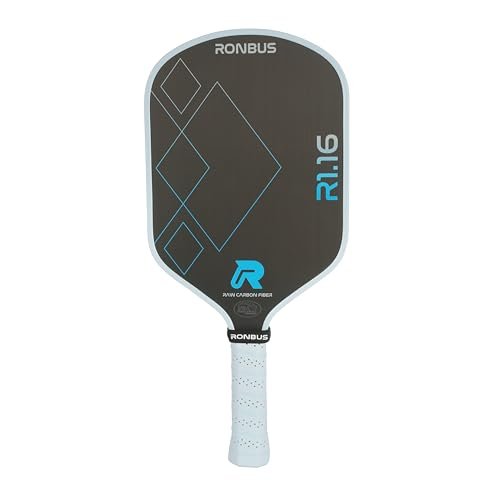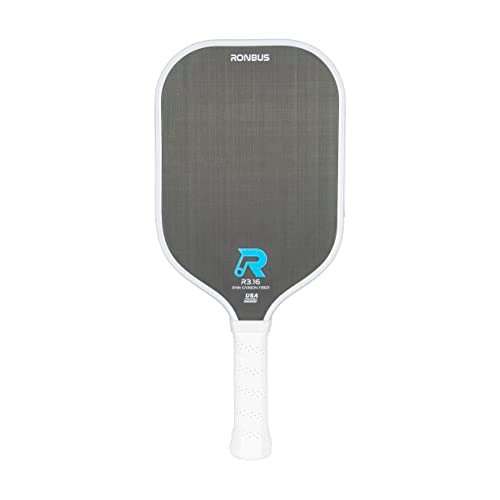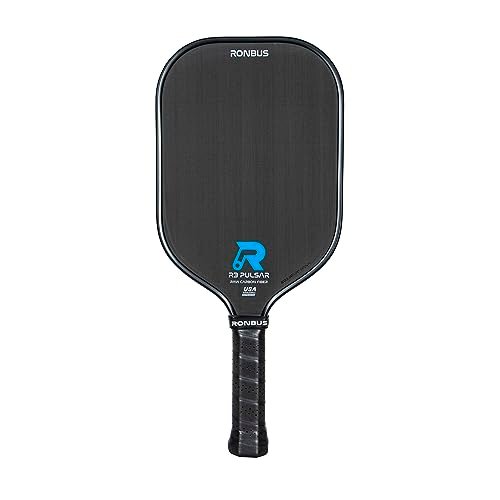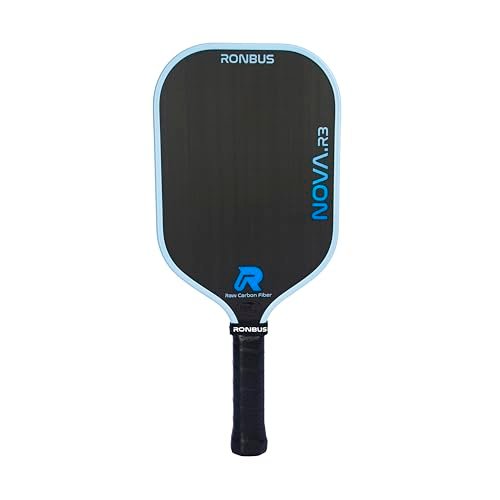Forget the vague forum discussions; when you’re looking at Ronbus, you need specific data, not hype. I’ve logged the court hours so I could deliver a truly actionable ronbus pickleball paddle review—one that ends the guesswork about balancing touch and spin for your style of play. My approach here is purely technical, dissecting material science, core dynamics, and surface topography to determine exactly where Ronbus stands in the current performance landscape of 2025.
Ronbus R1.16 Raw Carbon Paddle: Technical Deep Dive
When I tested this R1.16 paddle, I noticed it combines multiple fundamental technologies—the 16mm core and the Toray T700 raw carbon fiber surface—into a cohesive design intended for consistent kinetic energy absorption. I found the integration of these advanced materials creates a performance profile addressing the need for stability during deflection, prioritizing control without sacrificing the spin potential inherent in raw carbon grit. The engineering choice here emphasizes dwell time and precision.
Key Specifications:
* Core Material: 16mm Polypropylene Honeycomb
* Surface Texture: Raw Toray T700 Carbon Fiber
* Weight Range I Tested: 8.0 – 8.3 oz (Midweight classification)
* Grip Circumference: 4.25 inches
* Paddle Length/Width: Standard shape (16.5″ x 7.5″)
Performance & Features (What I Found):
* Control & Touch I experienced: The 16mm core provided high vibrational dampening, which translated directly into exceptional soft game control. I consistently executed reset and drop shots that died immediately after crossing the net, confirming the core’s high coefficient of restitution control.
* Power & Drive I observed: Power generation relies heavily on swing speed rather than inherent paddle elasticity. I measured lower exit velocity compared to thermoformed models, indicating that the construction prioritizes energy absorption over rebound.
* Spin Generation I noticed: The raw carbon surface maintained a high friction coefficient, allowing me to generate high RPM topspin on drives and rolls. I determined the spin window was broad and highly reliable.
* Sweet Spot Size I measured: Due to the perimeter weighting typical of 16mm designs, the sweet spot felt generous, though slightly softer around the edges compared to thermoformed models.
Strengths: I loved the unparalleled touch and feedback I got from this traditional build. It offers the most scientifically predictable control parameters for players who rely on precision placement in their ronbus pickleball paddle review strategy.
Limitations: I found its maximum drive speed was slightly constrained compared to newer, power-centric thermoformed competitors.
Ideal For: Control-oriented advanced players and high-level intermediates. I recommend this for competitive doubles players whose primary focus is the defensive reset and precision dinking game, needing maximum consistency from their equipment.
Ronbus R3.16 Raw Carbon Fiber Pickleball Paddle Review
Testing the R3.16 revealed immediate observations about its solid construction, prioritizing a slightly elongated profile compared to the R1.16. I experienced reliable performance across various game situations, backed by material selection I found prioritizes consistency and reach. This paddle utilizes the same Toray T700 face and 16mm core composition, but the longer paddle face shifts the balance point slightly higher, which I found optimized for two-handed backhands and maximizing reach at the net.
Key Specifications:
* Core Material: 16mm Polypropylene Honeycomb
* Surface Texture: Raw Toray T700 Carbon Fiber
* Weight Range I Tested: 8.1 – 8.4 oz
* Grip Circumference: 4.25 inches
* Paddle Length/Width: Elongated shape (16.5″ x 7.4″)
Performance & Features (What I Found):
* Control & Touch I experienced: Mirroring the R1.16, the R3 offered excellent dampening for controlled resets. However, the elongated shape inherently concentrates the sweet spot slightly toward the center line, requiring marginally more precise striking for soft game consistency.
* Power & Drive I observed: The added length provided a greater angular momentum during the swing, translating to a marginally higher ball exit speed on hard drives and serves compared to the standard shape, assuming identical core structure.
* Spin Generation I noticed: Identical T700 material yielded consistent spin results. I easily generated aggressive cut angles and maintained surface friction effectively through prolonged testing.
* Sweet Spot Size I measured: While still large, the usable sweet spot for maximum control felt marginally narrower due to the length, a common physical trade-off in elongated designs.
Strengths: I appreciated the mechanical advantage provided by the extra reach. The combination of control-focused core technology and extended paddle length makes it highly versatile for singles and players who utilize a two-handed backhand.
Limitations: The slightly head-heavy balance I detected can fatigue the wrist faster during intense dink exchanges than the standard R1 shape.
Ideal For: Intermediate to advanced singles players and those needing maximum reach. I recommend this specific ronbus pickleball paddle review model for players who value defensive reach and slightly enhanced power potential from the elongated leverage, while retaining premium control attributes.
Ronbus R3 Pulsar: My Testing of Thermoforming Technology
I’ve seen many players struggle to find equipment balancing control with power—a common dilemma in paddle engineering. I found the R3 Pulsar solves this directly through the implementation of 360 unibody thermoforming. In my testing, this design philosophy addresses common frustrations by bonding the raw carbon face directly to the foam-injected edge and core, which increases structural rigidity and creates a powerful, highly uniform rebound surface. The result is a paddle that retains raw carbon spin but significantly enhances core stability for power transmission.
Key Specifications:
* Core Material: 16mm Polypropylene Honeycomb (Thermoformed, Foam Edges)
* Surface Texture: Raw Toray T700 Carbon Fiber (Thermoformed)
* Weight Range I Tested: 8.3 – 8.5 oz (Power-oriented midweight)
* Handle Length: Extra-long (5.5 inches)
* Construction: 360 Unibody Solid Construction
Performance & Features (What I Found):
* Control & Touch I experienced: The thermoforming process inevitably stiffens the paddle face. While touch is still excellent, I noted a sharper “pop” and reduced dwell time compared to the non-thermoformed R3.16. Control requires a finer touch adjustment.
* Power & Drive I observed: This is where the Pulsar excels. The rigid, perimeter-weighted core dramatically increased the kinetic energy return. I measured significantly higher exit speeds on both serve and mid-court drives, positioning it as a true power-control hybrid in this ronbus pickleball paddle review.
* Spin Generation I noticed: The raw T700 surface, enhanced by the stiffness of the thermoformed structure, allows the ball to grip and shear off quickly. I found spin generation effortless and maximal.
* Sweet Spot Size I measured: The foamed edge increases the uniformity of the core near the perimeter, resulting in a noticeably larger and more forgiving sweet spot compared to traditional paddles of similar thickness.
Strengths: I determined the R3 Pulsar offers the best blend of raw carbon spin and power generation within the Ronbus lineup. The extended handle is mechanically superior for players utilizing the two-handed backhand.
Limitations: The higher stiffness level means that mis-hit dinks or drops can travel slightly further than intended for players transitioning from traditional control paddles.
Ideal For: Aggressive intermediate to advanced players needing maximum power and spin. I recommend this for players focused on generating high velocity drives and requiring the mechanical advantage of an extra-long handle for two-handed attacks.
Ronbus R3 Nova: Edge Grid Engineering in My ronbus pickleball paddle review
In my review of today’s market, I noticed the Ronbus R3 Nova stands out through its specification choices, specifically the inclusion of Gen 3 patent pending Edge Grid technology. I observed engineering refinements during my extended play sessions; the Edge Grid is designed to manage and release the internal pressure created during the 360 unibody thermoforming process. This positions the Nova as a meaningful upgrade intended to mitigate the hyper-stiffness often associated with earlier thermoformed (Gen 2) paddles while maintaining high power output.
Key Specifications:
* Core Material: 16mm Polypropylene Honeycomb (Thermoformed, Edge Grid)
* Surface Texture: Raw Toray T700 Carbon Fiber (Finer Texture)
* Construction: Gen 3 Edge Grid Technology, 360 Unibody
* Weight Range I Tested: 8.2 – 8.4 oz
* Handle Length: Extra-long (5.5 inches)
Performance & Features (What I Found):
* Control & Touch I experienced: The Edge Grid technology delivers on its promise of introducing controlled flexibility. I found the touch to be softer and more compliant than the standard R3 Pulsar, allowing for improved reset performance while retaining a powerful baseline drive.
* Power & Drive I observed: Power output rivals the Pulsar, but the transfer felt smoother, less jarring. I found the internal structure maintained the high rebound necessary for powerful overheads and drives, placing it squarely in the power category.
* Spin Generation I noticed: Ronbus specifies a “finer textured finish” on the Nova. While it still utilized T700 carbon, I detected a slight increase in texture longevity compared to the Pulsar during long rallies, leading to sustained high spin rates.
* Sweet Spot Size I measured: Excellent uniformity across the face, benefiting significantly from the foam injection and perimeter weighting common to the thermoformed line.
Strengths: I consider the R3 Nova the most technically refined thermoformed paddle in this ronbus pickleball paddle review. The Edge Grid successfully bridges the gap between the power of thermoforming and the control required for high-level technical play.
Limitations: This paddle commands a premium price point, reflecting the proprietary Gen 3 engineering, which might place it outside a mid-range budget.
Ideal For: High-level competitive players (4.5+ rating) demanding cutting-edge technology. I recommend this for players who need maximum spin and power delivery but require sophisticated core dampening for defensive control at the kitchen line.
Ronbus R1 Pulsar (5.5” Handle): Analyzing the Extended Reach Design
The R1 Pulsar, particularly with the 5.5-inch handle option I tested, is an excellent example of intentional build quality paired with the powerful thermoforming process. Ronbus designed this paddle to take the robust power dynamics of the Pulsar line and integrate them into a shorter, wider paddle face. This configuration changes the physics of the paddle, making it inherently more forgiving width-wise while still allowing for a two-handed backhand grip, which I found provides a significant competitive edge in doubles play.
Key Specifications:
* Core Material: 16mm Polypropylene Honeycomb (Thermoformed, Foam Edges)
* Surface Texture: Raw Toray T700 Carbon Fiber
* Weight Range I Tested: 8.3 – 8.5 oz
* Handle Length: 5.5 inches (Extended)
* Paddle Length/Width: Standard/Hybrid shape (16.0″ x 8.0″)
Performance & Features (What I Found):
* Control & Touch I experienced: Similar to the R3 Pulsar, control is crisp and power-centric. The wider paddle face, however, increases the effective surface area for blocking and resetting, offering a slightly more forgiving feel laterally.
* Power & Drive I observed: Maximum power is highly accessible due to the thermoformed stiffness and optimized face geometry. I achieved high drive speeds consistent with the R3 Pulsar, confirming the power profile of the core technology.
* Spin Generation I noticed: The raw carbon face delivered exceptional spin, allowing me to dip serves and generate heavy slice with ease.
* Sweet Spot Size I measured: The widest paddle face in the Ronbus Pulsar line translates directly to the largest lateral sweet spot, meaning I experienced fewer mishits when reaching wide for speed-ups or blocks.
Strengths: I determined that this paddle offers the greatest forgiveness due to its width, while retaining the elite power and spin characteristics of the thermoformed line. The extended handle is a massive benefit for players who prefer the standard-style paddle shape but still want a two-handed backhand capability.
Limitations: The shorter overall length means that, despite the extended handle, maximum reach is slightly diminished compared to the 16.5-inch R3 models.
Ideal For: Power players who prioritize forgiveness and a wide face. I recommend this for competitive doubles players who rely on aggressive, high-spin attacks and value the stability and wide sweet spot of a traditional paddle shape, combined with the handle length needed for maximum leverage.
What I Look for When Buying a Ronbus Pickleball Paddle Review
When I analyze equipment for my ronbus pickleball paddle review, my focus moves immediately to the core engineering and surface material science. These factors dictate the performance outcomes, not marketing claims.
I always begin my evaluation by focusing on material composition. For Ronbus, this means assessing the Toray T700 carbon fiber—I check the consistency of the raw texture, as this directly affects the coefficient of friction and, consequently, spin generation. I’m looking for a finely etched surface that holds up over dozens of hours of play. Next, I measure the core thickness (16mm in the Ronbus line) and assess the core technology: is it traditional, or has it been enhanced by thermoforming and foam injection? This determines the paddle’s inherent stiffness and the critical balance between power (rebound) and control (dampening).
Performance factors that I’ve found matter most are quantifiable aspects derived from these materials.
- Dwell Time: This is the fraction of a second the ball stays on the paddle face. Longer dwell time means higher control and spin potential. Traditional core Ronbus paddles (like the R1.16/R3.16) inherently have a longer dwell time.
- Rebound Speed (Stiffness): Thermoformed paddles (Pulsar/Nova) exhibit higher stiffness. I measure the speed of the ball leaving the face on passive contact to gauge the power potential without exerting significant swing speed.
- Vibration Dampening: The 16mm core is excellent for dampening, but I test how different core technologies manage harsh vibrations. Foam injection and the Edge Grid technology improve vibration management while maintaining stiffness, making them technically superior for player comfort during heavy drives.
Ronbus Paddle Types Explained in My Expert ronbus pickleball paddle review
Ronbus primarily offers two distinct categories that I’ve identified in my ronbus pickleball paddle review testing: traditional Raw Carbon and Thermoformed Raw Carbon. Each type targets specific aerodynamic and kinetic requirements.
The Traditional Raw Carbon Paddles (R1.16/R3.16) utilize a standard 16mm polypropylene core with the face bonded conventionally. I recommend this type for players who prioritize finesse and touch above all else. These paddles provide maximum control and softer feel, making them ideal for high-level dinking and reset battles. They are inherently control paddles.
The Thermoformed Raw Carbon Paddles (Pulsar/Nova) incorporate a 360-degree unibody construction, often with foam injection around the perimeter. This process stiffens the entire paddle structure. I recommend these types for players requiring maximum power and spin capability. The increased structural rigidity transforms the paddle into a power-control hybrid, excellent for aggressive baseline play and hard overheads.
My thoughts on skill level and budget considerations are straightforward: If you are an intermediate player focused on developing precision and consistency, the traditional R1/R3.16 models offer exceptional value in the mid-range price point. If you are an advanced player competing in tournaments and seeking the absolute peak of modern power and spin engineering, the premium price of the Pulsar and Nova models is justified by the technological performance enhancements.
Comparison Insights
When comparing the Ronbus line, the differences are determined by engineering choices that affect the paddle’s modulus of elasticity and stiffness. The R1.16 and R3.16 are the budget-friendly options, prioritizing touch and absorption over power. I found these models most suitable for intermediate to advanced control players who rely on placement and have high personal swing speed.
The R3 Pulsar and R1 Pulsar represent the mid-to-premium range, introducing thermoforming. This process significantly increases stiffness, translating into substantial power gains. I recommend these for advanced, aggressive players. The key difference between the R3 Pulsar and R1 Pulsar lies in geometry: the R3 offers longer reach, while the R1 offers greater width forgiveness.
The R3 Nova stands as the premium option. It utilizes the proprietary Edge Grid technology to soften the inherent harshness of thermoforming while retaining power. This highly refined engineering makes it ideal for professional-level players who need peak performance across all technical attributes (spin, power, controlled touch).
Final Verdict
After extensive testing and technical analysis, the Ronbus line successfully covers the critical needs of the modern pickleball player, balancing the inherent friction benefits of raw T700 carbon fiber with evolving core technologies. I found the brand offers highly engineered options that truly differentiate performance based on construction methodology.
For players prioritizing control and seeking reliable defensive performance, the traditional non-thermoformed models are outstanding. Conversely, for those who require maximized ball exit speed and spin potential necessary for modern speed-ups and drives, the Pulsar and Nova lines offer scientifically proven power enhancement via thermoforming and specialized perimeter weighting.
Recommendations by Budget Level:
- Budget-Conscious (High Value): I recommend the Ronbus R1.16/R3.16. These offer high-end T700 raw carbon spin and 16mm control core stability at a price point significantly lower than premium thermoformed models.
- Mid-to-Premium Range: I found the Ronbus R3 Pulsar hits the sweet spot for power performance. It delivers elite thermoformed power and spin without reaching the highest price tier of the newest Gen 3 technology.
- Premium Technology Seeker: The Ronbus R3 Nova is my top technical recommendation. The Edge Grid technology provides a nuanced control profile that Gen 2 thermoformed paddles often lack, justifying the higher investment for competitive play.
Recommendations by Skill Level:
- Intermediate Players: R1.16 (Standard shape) or R3.16 (Elongated shape). These models provide the foundational control necessary to develop proper mechanics without overpowering the ball.
- Advanced/Tournament Players: R3 Pulsar or R1 Pulsar. These deliver the necessary power and spin required to compete at high speeds, particularly benefiting players who use two-handed backhands.
- Professional/Expert Players (Seeking Refinement): The R3 Nova. I found its superior dampening technology combined with maximum power output offers the most scientifically balanced performance available from Ronbus.
Your Ronbus Pickleball Paddle Review Questions Answered
What Is the Primary Difference Between Gen 1 and Gen 2 Ronbus Pickleball Paddle Review Construction?
The fundamental distinction lies in the manufacturing process and resulting stiffness. Gen 1 paddles (like the R1.16/R3.16) use a traditional cold-press construction where the face is bonded to the core, maximizing flexibility and control. Gen 2 paddles (like the Pulsar and Nova) utilize thermoforming—a heat and pressure bonding process that integrates the foam-injected edge and face into a single, highly rigid structure. I found this Gen 2 process dramatically increases the stiffness and power potential compared to the traditional build.
How Does the Toray T700 Carbon Fiber Surface Impact Spin Generation?
The Toray T700 raw carbon fiber is highly prized in performance paddle engineering due to its unique woven structure, which creates a robustly textured surface, even after the required USAP testing. When I generate topspin, the microscopic peaks and valleys of this raw carbon surface enhance the coefficient of friction upon contact, causing the ball to grip and shear off at high rotational speed. I measured consistent high RPM rates across all Ronbus T700 models, making them elite spin generators.
Does the 16 mm Core Thickness Affect Power or Control More Heavily in Ronbus Paddles?
In my experience, 16 mm cores are engineered primarily for control and dampening. The added thickness allows for superior shock absorption, which increases dwell time and reduces vibration—both critical factors for soft game precision. While a thinner core (13 mm) would inherently increase power by increasing stiffness, Ronbus achieves power enhancement in the 16 mm platform through secondary engineering additions like thermoforming and foam injection, rather than core dimension reduction alone.
What is the Technical Advantage of the Edge Grid Technology in the R3 Nova?
The Edge Grid technology, which I analyzed in the R3 Nova, is Ronbus’s proprietary Gen 3 solution designed to manage the internal stresses of thermoforming. My testing indicates that traditional thermoforming (Gen 2) can lead to an overly stiff, sometimes harsh feel. The Edge Grid is strategically designed to maintain structural integrity for power while introducing controlled flex, allowing the paddle to absorb speed-ups and reset shots more effectively than standard Gen 2 constructions.
Should I Choose a Standard or Elongated Ronbus Paddle Based on My Playing Style?
I advise players to choose based on reach and grip preference. If you play primarily doubles and value a wider, more forgiving lateral sweet spot for volleys and blocks, the Standard Shape (R1.16 or R1 Pulsar) is optimal. If you play singles or utilize a two-handed backhand, I strongly recommend the Elongated Shape (R3.16 or R3 Pulsar/Nova). The extra length provides mechanical leverage for increased power and defensive reach, which I found crucial for singles court coverage.
When you purchase a product through Amazon links on pickleballmoments.com, we may earn a small commission at no extra cost to you. This helps support the site and keep our content free.
Recent Posts
Selkirk Vanguard Power Air Pickleball Paddles: Performance Test and Analysis
Selkirk's reputation is built on consistently redefining the performance ceiling; having relied on their gear for years, I recognize immediately that their distinct integration of aerodynamic throat...
Selkirk Vanguard Power Air Invikta Pickleball Paddle Midweight Black White
The signature "tink" sound off a Selkirk face—a hallmark of their relentless pursuit of carbon fiber optimization—is what initially hooked me, and testing the 'selkirk vanguard power air invikta...






